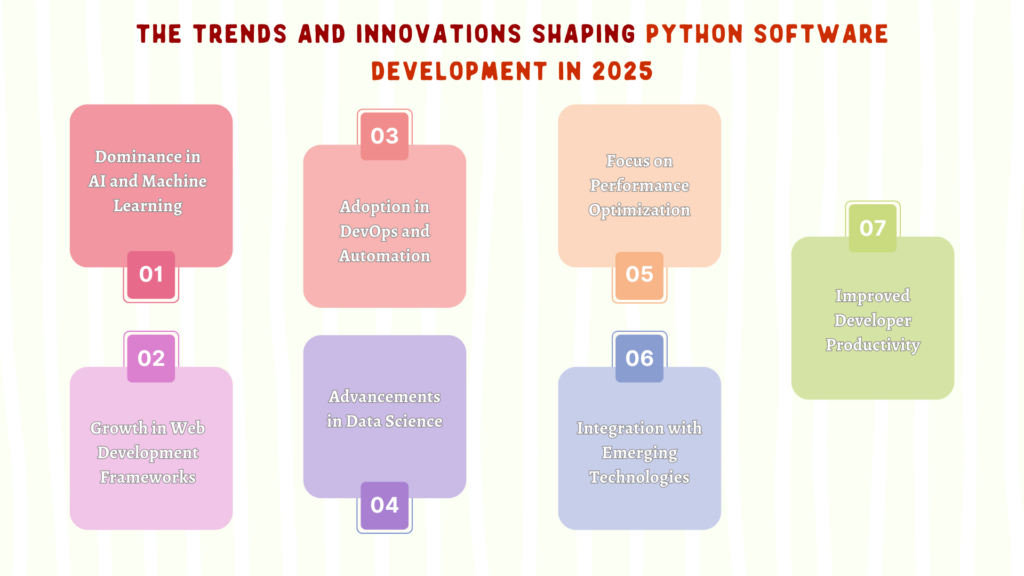27Nov

Python has firmly established itself as one of the most popular programming languages in the world, and its relevance continues to grow in 2025. Renowned for its simplicity, versatility, and robust community support, Python remains a go-to choice for software developers across industries. Let’s explore the trends and innovations shaping Python software development in 2025, as Python software development in 2025 continues to drive technological advancements.
Python software development is the process of creating, testing, and maintaining applications, systems, and software solutions using the Python programming language, leveraging its simplicity, versatility, and wide range of libraries and frameworks to build everything from web applications and data-driven solutions to machine learning models, automation scripts, and performance-optimized systems, while also integrating with emerging technologies like DevOps, cloud computing, and artificial intelligence.

Python remains the dominant language for AI and machine learning applications. Frameworks like TensorFlow, PyTorch, and Scikit-learn have evolved with even more advanced features, catering to the growing demands for efficient, scalable, and interpretable models. In 2025, Python’s role in AI is bolstered by:
Frameworks like Django, Flask, and FastAPI continue to dominate web development. FastAPI, in particular, has gained immense popularity due to its speed and ease of use for building RESTful APIs. In 2025, web developers are leveraging Python for:
Python’s scripting capabilities make it an essential tool for DevOps professionals. Automation and infrastructure-as-code practices are streamlined with Python-based tools such as Ansible and SaltStack. In 2025, Python is widely used for:
Python’s presence in data science is unmatched. Libraries like Pandas, NumPy, and Matplotlib are now more efficient and versatile. In 2025, developers are leveraging Python for:
While Python is often criticized for its performance compared to compiled languages, 2025 has seen strides in optimization. With the growth of tools like PyPy and Cython, developers are achieving:
Python’s adaptability ensures its place in emerging tech fields:
The Python ecosystem in 2025 emphasizes enhancing developer productivity. Key trends include:
Python software development in 2025 is marked by its adaptability and growing influence across industries. From AI to web development, data science to DevOps, Python continues to evolve, meeting the needs of modern developers. By staying updated with the latest Python trends and tools, developers can harness its full potential to build innovative and impactful software solutions.
KENFRA Research will support Python software development in 2025 by offering tailored solutions, code optimization, integration with emerging technologies, and expert guidance to streamline development and enhance productivity.

Publishing your research in a peer-reviewed journal is one of the most effective ways to share your academic contribution with... read more
Image processing is a famous exploration field that arrangements with various applications and its processing. It is explicitly utilized in... read more
IIT-BHU students introduced to real-world industry practices IIT-BHU, or the Indian Institute of Technology (IIT) - Banaras Hindu University, is a... read more
Future-proof your data science career by enrolling in IIM Kozhicode's Data science & Artificial intelligence program Introduction:In a rapidly evolving digital... read more

Completing a PhD thesis is a monumental task. It’s not just about writing; it’s about writing well, writing consistently,... read more

Starting a PhD in 2025 is both an opportunity and a challenge. With evolving research methods and new tools,... read more

The pursuit of a PhD is a transformative journey that expands your academic horizons and opens doors to global opportunities.... read more

Best Tools for Academic Proofreading and Editing read more

The PhD journey is one of the most challenging and rewarding academic pursuits. It's a path filled with intellectual... read more
WhatsApp us
Leave a Reply